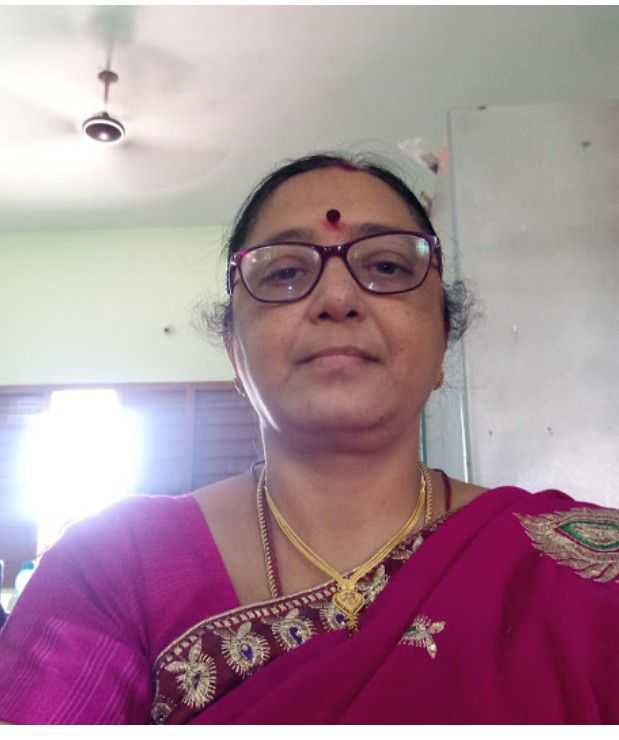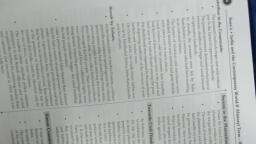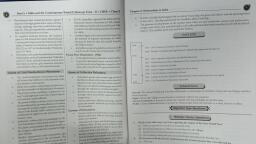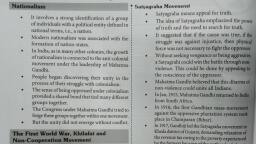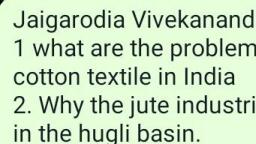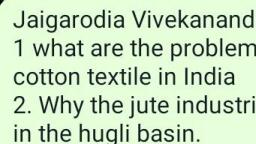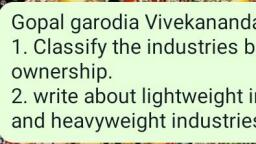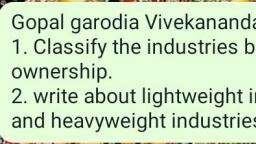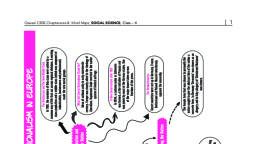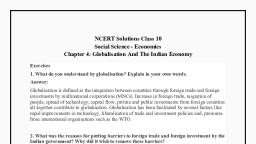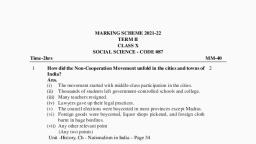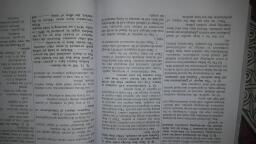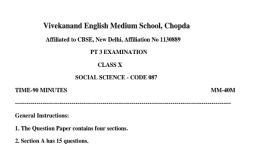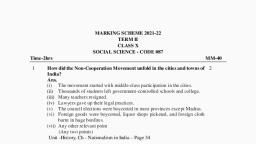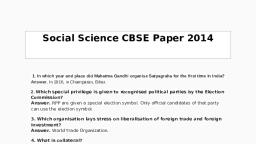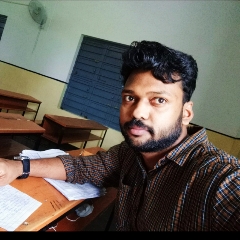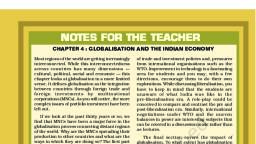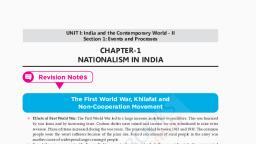Page 1 :
Sample Question Paper - 7, Social Science (087), Class- X, Session: 2021-22, TERM II, Time Allowed: 120 minutes, Maximum Marks: 40, General Instructions:, 1. The question paper consists of 14 questions divided into 3 sections A, B, C., 2. All questions are compulsory., 3. Section A comprises of 6 questions of 2 marks each. Internal choice has been provided in two questions., 4. Section B comprises of 4 questions of 3 marks each. Internal choice has been provided in one question., 5. Section C comprises of 4 questions of 4 marks each. An internal choice has been provided in one question. It, contains two case study based questions., , Section A, 1., , Why did the Muslims fail to respond to, the call of unified struggle during Civil Disobedience Movement ? Explain., , 2., , Describe in brief the reactions of the people immediately after Jallianwalla Bagh incident., , 3., , Salim is a shoe manufacturer who has received an order from a large trader for 3000 pairs of shoes and Swapna is, a small farmer who grows groundnuts on her three acres of land. The following table gives the information about, their need of credit, risk involved and the outcome. Study the table and answer the questions that follow :, Salim, , Swapna, , Why did they need credit?, , To meet the working capital needs., , To meet the cultivation expenses., , What was the risk?, , Not delivering the goods on time, , Risk of crop failure, , What was the outcome?, , Supplied orders, earned profit and Crops failed and she found herself in, repaid the loan, the debt-trap., , 1., 2., , Supposing Salim continues to get orders from traders. What would be his position after 5 or 6 years ?, Mention any one reason that makes Swapna’s situation so risky., , 4., , What are Special Economic Zones (SEZs) ? Why have they been set up ?, , 5., , What is the role of MNCs in the globalisation process ?, , Section B, 6., , What is the importance of railway transport?, , 7., , Mention any two challenges faced by political parties in India. Give two suggestions that can help to reform the, functioning of political parties and its members., , �, �o, Explain why road transport still needs to be developed in India. What are the priority areas ?
Page 2 :
8., , Why is a democratic government considered better than dictatorship? Explain any three reasons., , Section C, 9., , How did the industrialists relate to the Civil Disobedience Movement Analyse their role., �, �o, Describe the Peasant Rebellion in Awadh during the Non-Cooperation Movement., , 10., , Cotton textile industry was concentrated in certain areas. Name the factors responsible for its localisation. How, is this industry beneficial for the local people ?, �, �o, Write any five characteristics of sugar industry of India., , Section D, 11., , Read the extracts/sources carefully and answer the following questions:, Our interest in and fascination for democracy often pushes us into taking a position that democracy can address, all socio-economic and political problems. If some of our expectations are not met, we start blaming the idea, of democracy. Or, we start doubting if we are living in a democracy. The first step towards thinking carefully, about the outcomes of democracy is to recognise that democracy is just a form of government, It can only create, conditions for achieving something. The citizens have to take advantage of those conditions and achieve those, goals., Question :, 1., State any two problems on which democracy has failed., 2., How does democracy create conditions for a better government? Explain by giving two examples., 3., What is the first step towards thinking carefully about the outcomes of democracy?, , 12., , Read the extract and answer the questions that follow :, In general, MNCs set up production where it is close to the markets, where there is skilled and unskilled labour, available at low costs and where the availability of other factors of production is assured. In addition,, MNCs might look for government policies that look after their interests. Having assured themselves of these, conditions, MNCs set up factories and offices for production. The money that is spent to buy assets such as, land, building, machines and other equipment is called investment. Investment made by MNCs is called foreign, investment. Any investment is made with the hope that these assets will earn profits., At times, MNCs set up production jointly with some of the local companies of these countries. The benefit to the, local company of such joint production is two-fold. First, MNCs can provide money for additional investments,, like buying new machines for faster production. Second, MNCs might bring with them the latest technology for, production., But the most common route for MNC investments is to buy up local companies and then to expand production., MNCs with huge wealth can quite easily do so. To take an example, Cargill Foods, a very large American MNC,, has bought over smaller Indian companies such as Parakh Foods. Parakh Foods had built a large marketing, network in various parts of India, where its brand was well-reputed. Also, Parakh Foods had four oil refineries,, whose control has now shifted to Cargill. Cargill is now the largest producer of edible oil in India, with a capacity, to make 5 million pouches daily. In fact, many of the top MNCs have wealth exceeding the entire budgets of the, developing country governments. With such enormous wealth, imagine the power and influence of these MNCs., Question :, 1., Write any two conveniences for which MNCs set production., 2., What is the difference between investment and foreign investment ?, 3., What is the common route for MNC investments? Give an example.
Page 3 :
Section E, 13., , On the given outline Political Map of India, locate the following:, A., The place where the Indian National Congress session was held in September, 1920, B., Namrup Thermal Power Plant, �, �O, C., D., , Indore Cotton Textile Industry, Rajiv Gandhi International Airport
Page 4 :
Solution, Social Science (087), Class 10 - Social Science, Time: 2 Hours, Max. Marks: 40, General Instructions:, 1. This Question paper is divided into five sections-Section A, B, C, D and E., 2. All questions are compulsory., 3. Section-A: Question no. 1 to 5 are very short answer type questions of 2 marks each. Answer to each question, should not exceed 40 words., 4. Section-B: Question no. 6 to 8 are short answer type questions, carrying 3 marks each. Answer to each question, should not exceed 80 words., 5. Section-C: Question no. 9 and 10 are long answer type questions, carrying 5 marks each. Answer to each, question should not exceed 120 words., 6. Section-D: Question no. 11 and 12 are Case Based questions., 7. Section-E: Question no. 13 is map based, carrying 3 marks with two parts, 13.1 from History (1 mark) and 13.2, from Geography (2 marks)., 8. There is no overall choice in the question paper. However, an internal choice has been provided in a few, questions. Only one of the choices in such questions have to be attempted., 9. In addition to this, separate instructions are given with each section and question, wherever necessary., , Section A, 1., , Why did the Muslims fail to respond to, the call, of unified struggle during Civil Disobedience, Movement ? Explain., �, �Ans :, During Civil Disobedience Movement Muslims, did not take part in unified struggle. The main, reason was that in the year 1933 Rehmat Ali, uttered the word Pakistan in one meeting which, grew the narrow and selfish feelings in the hearts of, Muslims. It was accepted by Mohammad Ali Jinna, the leader of Mohammadans of Bharat. He put this, feelings before the Muslims of India. On this basis, maximum muslims decided not to take part in Civil, Disobedience Movement., , 2., , Describe in brief the reactions of the people, immediately after Jallianwalla Bagh incident., , 3., , Salim is a shoe manufacturer who has received an, order from a large trader for 3000 pairs of shoes and, Swapna is a small farmer who grows groundnuts on, her three acres of land. The following table gives the, information about their need of credit, risk involved, and the outcome. Study the table and answer the, questions that follow :, Salim, , Swapna, , Why did, they need, credit?, , To meet the, working capital, needs., , To meet the, cultivation, expenses., , What was, the risk?, , Not delivering, the goods on, time, , Risk of crop, failure, , What, was the, outcome?, , Supplied orders,, earned profit, and repaid the, loan, , Crops failed, and she found, herself in the, debt-trap., , 1., , �, �Ans :, (i) As the news of Jallianwalla Bagh spread, the, crowd took to streets in many North Indian, towns., (ii) There were strikes, clashes with the police and, attack on government buildings., (iii) The government responded with brutal, repression, seeking to humiliate and terrorise, the people. Satyagrahis resisted with courage., , 2., , Supposing Salim continues to get orders from, traders. What would be his position after 5 or, 6 years ?, Mention any one reason that makes Swapna’s, situation so risky., , �, �Ans :, 1., , Supposing Salim continues to get orders from, traders for the next 5 or 6 years, he may use, his profits to fund his shoe business in future., he may not be required to take a loan in future
Page 5 :
2., , 4., , developed in India. What are the priority areas ?, , from any source of credit., Failure of crops due to attack on the crops by, pests and she may get trapped in the debttrap., , �, �Ans :, Road transport still needs to developed in India due, to following reasons :, (i) Construction cost of roads is much than that of, railway line., (ii) It is economical in transportation of few, persons, smaller amount of goods over short, distances., (iii) It provides door to door service and reduces the, cost of loading and unloading., (iv) Road transport connects fields with markets, and factories with farms., (v) Road transport is used to provide a link, between railway stations, air and sea ports. It, is, thus, used as a feeder to other modes of, transport., Rural areas as well as northern and north-eastern, border areas are the areas of priority., , What are Special Economic Zones (SEZs) ? Why, have they been set up ?, �, �Ans :, Special Economic Zones are those industrial areas, which have been specially set up to attract foreign, companies to invest in India. In such Special, Economic Zones, world class facilities like electricity,, water, transport, storage, roads, recreational and, educational facilities are available. Moreover, in, such Special Economic Zones, those companies who, set up their units are provided relaxation in taxes, an initial period of five years., , 5., , What is the role of MNCs in the globalisation, process ?, �, �Ans :, , 7., , Role of MNCs in process of globalisation:, Globalisation is the process of rapid integration, or interconnection between countries. MNCs are, playing a major role in the globalisation process., More and more goods and services, investments, and technology are moving between countries. Most, regions of the world are in closer contact with each, other than a few decades ago., , �, �Ans :, 1., , Following are the two challenges faced by, political parties in India :, (i) Lack of internal democracy., (ii) Use of money and muscle power., (iii) Do not offer any meaningful choice to the, voters., (iv) Dynastic succession., 2. Following suggestions may help to reform the, functioning of political parties and its members, :, (i) Regulation of internal affairs of political, parties., (ii) Reservation of seats for women in the party., (iii) State funding of elections., , Section B, 6., , What is the importance of railway transport?, �, �Ans :, (i) Indian Railways carry most of the long distance, passengers traffic and 80% of the total freight, of the country., (ii) iron and steel industry solely depends upon, the railways as they need it to transport raw, materials and finished goods of the industry, from one place to another., (iii) The Indian Railways provide employ-ment to a, huge number of people in the country., (iv) Railways play a significant role in the, integration of the country by bringing different, people of different regions together., (v) They carry big chunks of goods from the place, of production to the ports and, vice versa., �, �o, Explain why road transport still needs to be, , Mention any two challenges faced by political, parties in India. Give two suggestions that can help, to reform the functioning of political parties and its, members., , 8., , Why is a democratic government considered better, than dictatorship? Explain any three reasons., �, �Ans :, 1., 2., 3., 4., , In a democratic set up, there are regular, free, and fair elections., Unlike dictatorship, in a democracy, there is, open debates on major policy decisions., A democracy is always attentive to the needs of, the people., Democratic governments have the popular, support of the voters hence they are legitimate, government.
Page 6 :
5., , them from the clutches of the landlords. Within, a month 300 branches had been set up in the, villages., (vi) The movement spread quickly. In 1921, the, houses of taluqdars and merchants were, attacked, bazaars were looted and grain hoards, were taken over., , Women and weaker sections of the society have, better status in a democracy., , Section C, 9., , How did the industrialists relate to the Civil, Disobedience Movement Analyse their role., �, �Ans :, (a) Causes : They were against colonial policies, that restricted business activities., (b) Aim : They wanted protection against imports, of foreign goods and a rupee-sterlin foreign, exchange ratio that would discourage imports., (c) Activities : They gave financial assistance and, supported Civil Disobedience Movement as, mentioned below :, (i) They formed the Indian Industrial and, Commercial Congress in 1920 and the, Federation of the Indian Chamber of, Commerce and Industries (FICCI) in 1927., (ii) They refused to sell or buy imported goods., Most businessmen came to see Swaraj as a time when, colonial restrictions on business would no longer, exist and trade and industry would flourish without, constraints. But after the failure of the Round, Table Conference, business groups were no longer, uniformly enthusiastic. They were apprehensive of, the spread of militant activities. They were also, worried about prolonged disruption of business, as, well as of the growing influence of socialism amongst, the younger members of the Congress., �, �o, Describe the Peasant Rebellion in Awadh during, the Non-Cooperation Movement., �, �Ans :, (i) The peasants of Awadh during the movement, were led by Baba Ramchandra. He was a, Sanyasi and had earlier worked in Fiji as, indentured labour., (ii) The peasants’ movement was started to demand, reduction of revenue, abolition of begar and, social boycott of landlords., (iii) During the movement at many places NaiDhobi bandhs were organised. It was organised, to deprive landlords of the services of even, washermen and barbers., (iv) The movement was against taluqdars and, landlords who charged high revenue from the, peasants., (v) In 1920, Jawahar Lal Nehru formed ‘Oudh, Kisan Sabha’ to help the peasant to drive out, , 10., , Cotton textile industry was concentrated in, certain areas. Name the factors responsible for its, localisation. How is this industry beneficial for the, local people ?, �, �Ans :, Cotton textile industry was largely concentrated, in Maharashtra and Gujarat due to the following, reasons :, (i) Availability of raw cotton : These areas are, covered with black soils which are the most, suitable for growing cotton., (ii) Moist climate : Climatic conditions are also, favourable for cotton., (iii) Market : These are based on more urbanised, city of India. There exists a big market exist for, textile orient products., (iv) Transport : Developed means of transport, helped in the movement of raw materials and, finished products from one place to another., (v) Labourers : Skilled and unskilled labourers, were available in abundance., (vi) Port : Port facilities in Mumbai and Kandla, also favoured the establishment of cotton, textile industry., This industry is associated with agriculture and, provides living to farmers, cotton bale pluckers, and workers engaged in ginning, spinning, weaving,, dyeing, designing, packaging, tailoring and sewing., In this way, textile industry is beneficial for the, local people., �, �o, Write any five characteristics of sugar industry of, India., �, �Ans :, 1., 2., 3., , 4., , India stands second in the world as producer, of sugar but occupies the first place in the, production of gur and khandsari., In 2010-11, there were over 662 sugar mills in, the country., These mills were located in the states of Uttar, Pradesh, Bihar, Maharashtra, Karnataka,, Tamil Nadu, Andhra Pradesh and Gujarat, along with Punjab, Haryana and Madhya, Pradesh., This industry is seasonal in nature.
Page 7 :
5., 6., 7., 8., , In recent years, there is a tendency for the mills, to shift to southern and western states., The sucrose content is higher in the sugarcane, of south India., The cooler climate of southern India also, ensures a longer crushing season., Most of the mills of south India are in, cooperative sector., , Section D, 11., , Read the extract carefully and answer the following, questions:, Our interest in and fascination for democracy often, pushes us into taking a position that democracy can, address all socio-economic and political problems., If some of our expectations are not met, we start, blaming the idea of democracy. Or, we start, doubting if we are living in a democracy. The first, step towards thinking carefully about the outcomes, of democracy is to recognise that democracy is just, a form of government, It can only create conditions, for achieving something. The citizens have to take, advantage of those conditions and achieve those, goals., Question :, 1. State any two problems on which democracy, has failed., 2. How does democracy create conditions for a, better government? Explain by giving two, examples., 3. What is the first step towards thinking carefully, about the outcomes of democracy?, �, �Ans :, 1. (a) Corruption., (b) Sharing information with the citizens., 2. (a) Democracy is an accountable responsive, and legitimate government., (b) Democracy maintains dignity and freedom, of citizens., 3. The first step towards thinking carefully about, the outcomes of democracy is to recognise that, democracy is just a form of government, It can, only create conditions for achieving something., , 12., , Read the extract and answer the questions that, follow :, In general, MNCs set up production where it is, close to the markets, where there is skilled and, unskilled labour available at low costs and where, the availability of other factors of production is, assured. In addition,, , MNCs might look for government policies that look, after their interests. Having assured themselves of, these conditions, MNCs set up factories and offices, for production. The money that is spent to buy, assets such as land, building, machines and other, equipment is called investment. Investment made by, MNCs is called foreign investment. Any investment, is made with the hope that these assets will earn, profits., At times, MNCs set up production jointly with, some of the local companies of these countries. The, benefit to the local company of such joint production, is two-fold. First, MNCs can provide money for, additional investments, like buying new machines, for faster production. Second, MNCs might bring, with them the latest technology for production., But the most common route for MNC investments, is to buy up local companies and then to expand, production. MNCs with huge wealth can quite easily, do so. To take an example, Cargill Foods, a very large, American MNC, has bought over smaller Indian, companies such as Parakh Foods. Parakh Foods, had built a large marketing network in various parts, of India, where its brand was well-reputed. Also,, Parakh Foods had four oil refineries, whose control, has now shifted to Cargill. Cargill is now the largest, producer of edible oil in India, with a capacity to, make 5 million pouches daily. In fact, many of the, top MNCs have wealth exceeding the entire budgets, of the developing country governments. With such, enormous wealth, imagine the power and influence, of these MNCs., Question :, 1. Write any two conveniences for which MNCs, set production., 2. What is the difference between investment and, foreign investment ?, 3. What is the common route for MNC, investments? Give an example., �, �Ans :, 1., 2., , 3., , MNCs set up production where it is close to the, markets, where there is skilled and unskilled, labour available at low costs., The money that is spent to buy assets such as, land, building, machines and other equipment, is called investment. Investment made by, MNCs is called foreign investment., The common route for MNC investments is to, buy up local companies and then to expand, production. MNCs with huge wealth can quite, easily do so. To take an example, Cargill, Foods, a very large Amer-ican MNC, has, bought over smaller Indian companies such as, Parakh Foods. Parakh Foods had built a large, marketing network in various parts of India,
Page 8 :
where its brand was well-reputed. Also, Parakh, Foods had four oil refineries, whose control, has now shifted to Cargill. Cargill is now the, largest producer of edible oil in India, with a, capacity to make 5 million pouches daily., , Section E, 13., , On the given outline Political Map of India, locate, the following:, A. The place where the Indian National Congress, session was held in September, 1920, B. Namrup Thermal Power Plant, �, �o, C. Indore Cotton Textile Industry, D. Rajiv Gandhi International Airport, A. Calcutta, B. Namrup Thermal Power Plant, �, �o, C. Indore Cotton Textile Industry, D. Rajiv, Gandhi, International, (Hyderabad), , �, �Ans :, , Airport
